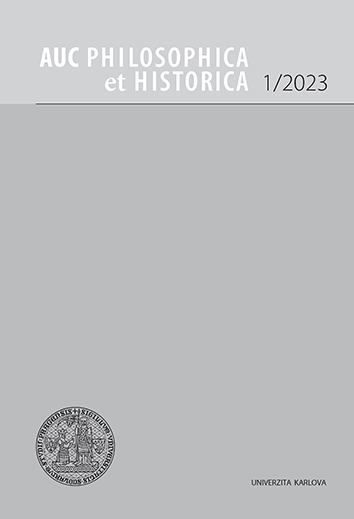AUC Philosophica et Historica je víceoborový akademický časopis zaměřený na humanitní a společenskovědné obory (filozofie, psychologie, pedagogika, sociologie, obecné, české a hospodářské dějiny, pomocné vědy historické a archivnictví, etnologie).
Časopis je indexován v databázích CEEOL, DOAJ a EBSCO.
AUC PHILOSOPHICA ET HISTORICA, Vol 2019 No 2 (2019), 201–207
Umění, vnímání a vizuální myšlení v kontextu teorií Rudolfa Arnheima
[Art, perception and visual thinking in the context of Rudolf Arnheim’s theory]
Šárka Jendraššák
DOI: https://doi.org/10.14712/24647055.2020.13
zveřejněno: 14. 09. 2020
Abstract
Knowledge of the world and education is traditionally based primarily on reading books, in which the main tool is the language that enables knowledge and education to be passed on to people. Since language is used to naming things and is an established means of communication, we understand it as a tool for interpreting reality, not for self-evaluation of a given reality. In this context, the image, and in our case, the work of art, is an authentic means of sensory communication, which is a direct form of communication, so its meaning is not interpreted in any way, that is, changed or enriched by other connotations and meanings. Sensory perception is thus based on the authentic experience of the recipient and creates the possibilities of language. German art psychologist Rudolf Arnheim (1904–2007) dedicated his lifelong research to the theories of sensory perception of art that lead to visual thinking. The language of art is understood as an expression medium that acts on the sensory component of human perception and thus creates the true reality of the seen. In this context, he devoted himself to the problem of analyzing the language of art, which he understood as the only authentic approach to reality. Art thus becomes a sovereign means of communication, which brings through the perceptual components a new interpretation of a given reality. Sensory perception of the seen is an active and creative process of comprehension that is composed of invention and intelligence. The characters are structured within the framework of the ten major visual categories that make up the whole of the seen. Art thus reveals the true nature of things and human existence, and that is one of its main roles. In connection with these theories the devotion to art, whether as a viewer or a theorist, develop our productive thinking and help us better understand the true reality of the world in which we live. This knowledge is authentic because it is based on our own sensory experience. This is not an interpretation or a given interpretation of a thing, but a matter in itself, which primarily affects our visual senses through the empathy, subjectivity, experience, emotions and knowledge of each person. Images are the basic elements that make up the human understanding of the world and without which we would not be able to fully understand human civilization.
klíčová slova: Perception of art; psychology of art; visual thinking; Rudolf Arnheim; viewer
reference (6)
1. Rudolf Arnheim papers, [undated] and 1932-1992, Archives of American Art, Smithsonian Institution.
2. Rudolf Arnheim, Visual Thinking, Berkeley - Los Angeles - London 1969.
3. Rudolf Arnheim, Art and Visual Perception, Berkeley - Los Angeles - London 1974. CrossRef
4. Dopis Rudolfa Arnheima z 12. května 1984 Williamu Burbackovi. Rudolf Arnheim papers, [undated] and 1932-1992, Archives of American Art, Smithsonian Institution.
5. Uta Grundmann - Rudolf Arnheim, The Intelligence of Vision: An Interview with Rudolf Arnheim, Cabinet II, 2001, č. 7. Dostupné z http://www.cabinetmagazine.org/issues/2/rudolfarnheim.php, vyhledáno 19. 7. 2017.
6. David A. Pariser, A Conversation with Rudolf Arnheim, Studies in Art Education, A Journal of Issues and Research XXV, 1984, č. 3, s. 176-184. CrossRef

Umění, vnímání a vizuální myšlení v kontextu teorií Rudolfa Arnheima is licensed under a Creative Commons Attribution 4.0 International License.
